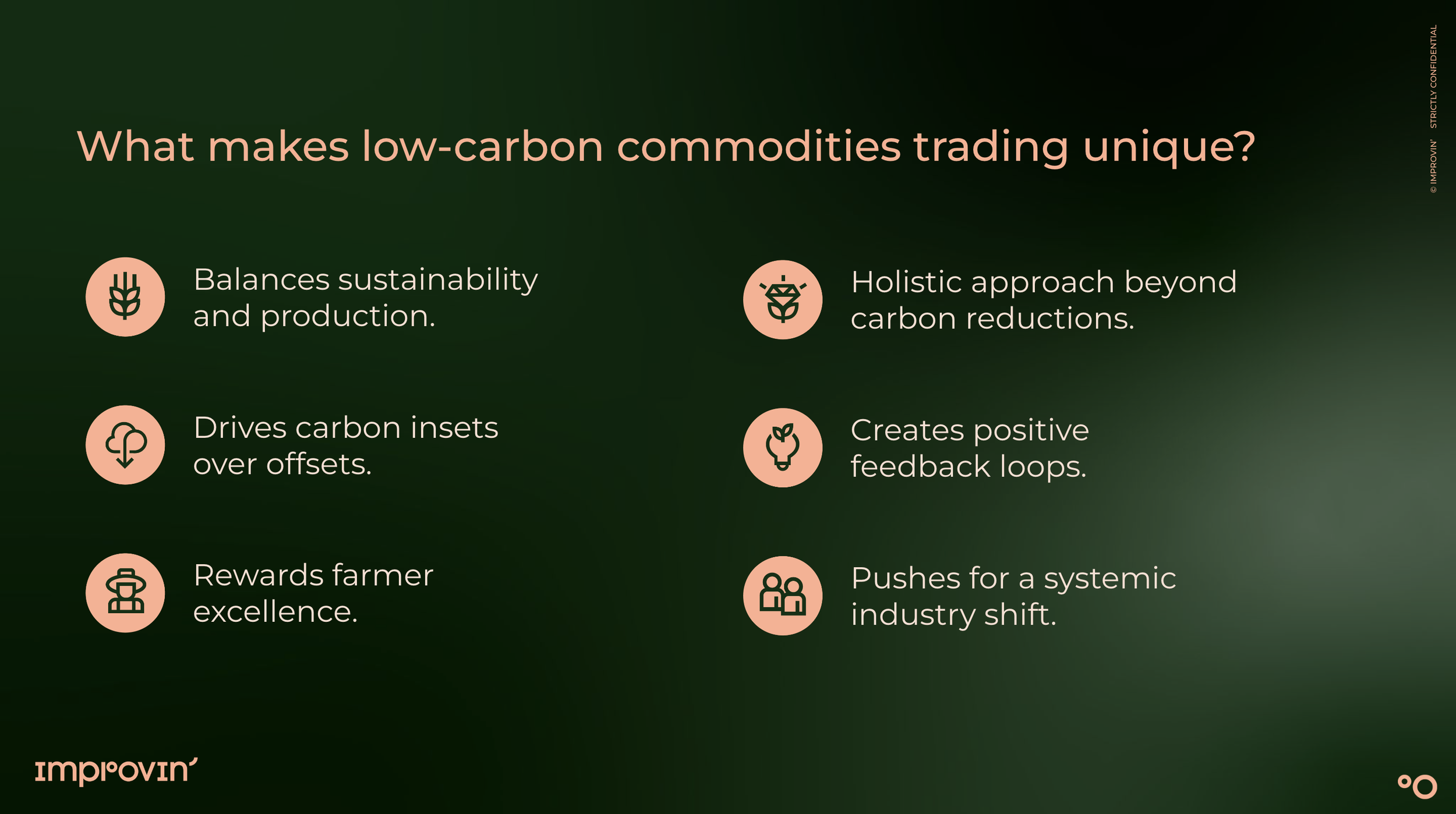Unveiling the potential of low-carbon agricultural commodities trading.
Agri-food businesses worldwide seek ways to achieve more sustainable food production without compromising output.
As the bulk of all food-related emissions come from primary production, improving the sustainability of any end product requires incentivizing farmers to adopt more sustainable farming practices.
This article delves into one solution that engages farmers while balancing both sustainability and production volumes: low-carbon agricultural commodities trading.
What is low-carbon agricultural commodities trading?
At its core, low-carbon commodities trading is a market-powered mechanism for improving the sustainability of agricultural products in a way that benefits everyone in the value chain.
Businesses engaged in the trade of agricultural commodities, such as farmers, mills, processors and grain traders, can earn a price premium by selling commodities, or products derived from them, that are produced sustainably to companies such as food and beverage manufacturers and FMCGs.
These companies can then, in turn, report their sustainability progress in line with the requirements of SBTi and similar sustainability commitments and market their products as more sustainable alternatives to their buyers and consumers.
Since there is now a premium attached to the entire chain of trades, the commodity buyers have a way to compensate the farmers who can demonstrate that their produce has a lower-than-average carbon footprint.
Of course, trading low-carbon commodities requires solid proof.
At every step, the seller must demonstrate that their goods are indeed more sustainable and, thus, more valuable than the bulk, starting with the farmers.
This need calls for verified primary data and rigorous carbon footprint calculations - more about that a little later.
What makes low-carbon commodities trading unique?
Low-carbon commodities trading stands out for its ability to balance sustainability with production volumes and its holistic approach to sustainable agriculture.
Let's have a closer look at why the mechanism is so well positioned to drive the green shift within the industry.
1 - Balancing sustainability and production.
Unlike other farmer-engaging mechanisms often used in agriculture, such as carbon sequestration, low-carbon trading ties sustainability directly to the traded volumes, avoiding the common pitfall of disconnecting environmental benefits from the produced volumes.
2 - Carbon insets over offsets.
Global sustainability reporting standards and commitments such as the Science Based Target Initiative, in particular their FLAG Guidance, push companies to move away from carbon offsets toward carbon insets: emissions reduced within one's own value chain.
Low-carbon trading offers an effective strategy for all companies in the value chain to claim verified emission reductions via carbon insetting.
3 - Rewarding excellence
Low-carbon trading not only incentivizes farmers to change their practices but also enables rewarding those who have already invested in regenerative farming and are showcasing best-in-class performance.
4 - Holistic approach beyond carbon reductions.
The benefits of sustainable farming extend beyond mere carbon reduction to enhanced soil health, reduced water usage, enhanced biodiversity, and improved resilience against climate change. Despite its name, low-carbon trading can promote and reward for all these benefits.
5 - Positive feedback loops
With low-carbon trading, farmers have a clear financial incentive to adopt, maintain and continue investing in new tools and technologies introducing more sustainable practices. This creates positive feedback loops for continuous improvement.
6 - Push for a systemic industry shift
Being market-based, low-carbon trading can catalyze a systemic shift towards sustainability in the global food and beverage industry, driven by the increasing market and consumer pressure and the need to show progress on the sustainability commitments, such as SBTi, that the companies have committed to.
How to engage in low-carbon agricultural commodities trading.
Because low-carbon commodities trading requires attaching sustainability values to the sold commodities at every step of the trade, engaging in it demands a solid method for gathering, verifying and quantifying on-farm sustainability data and turning the data into batch-specific carbon footprints.
We at Improvin’ offer a comprehensive solution for low-carbon commodities trading, facilitated by scalable primary data collection and certified batch-specific carbon footprint calculations.
With Improvin’, you can gather primary data from the farmers in your value chain - even if you don’t have direct relationships with them.
Based on this data, you can identify and certify your most sustainable commodity batches and position your low-carbon offering competitively in the market.
Would you like to hear more? Talk to our team.
Summary
Low-carbon agricultural commodities trading is a market-driven mechanism with great potential to power the green transition in the agri-food industry.
It aligns companies’ and farmers’ financial incentives with more sustainable food production practices without compromising production volumes and bridges them naturally to evolving consumer and sustainability reporting demands.
In addition, low-carbon trading can create a positive cycle: when farmers are paid more for their greener produce, the market encourages more farmers to adopt environmentally friendly practices, which drives emission reductions and accelerates the global shift to more sustainable food production.

